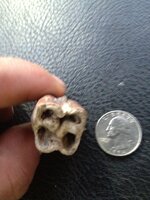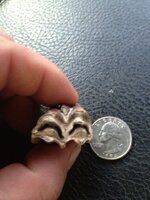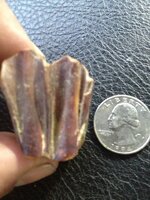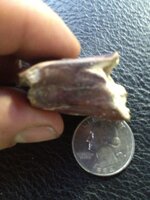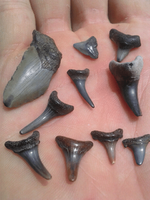Navigation
Install the app
How to install the app on iOS
Follow along with the video below to see how to install our site as a web app on your home screen.
Note: This feature may not be available in some browsers.
More options
You are using an out of date browser. It may not display this or other websites correctly.
You should upgrade or use an alternative browser.
You should upgrade or use an alternative browser.
Need help identifing a tooth
- Thread starter wvdirtdigger
- Start date
bci101tractors
Hero Member
- Jan 10, 2013
- 536
- 277
- Detector(s) used
- whites dfx
garret 250
- Primary Interest:
- All Treasure Hunting
Cow/calf/heifer molar would be my guess?
Thanks for posting and HH!! Nice find.
BCI
Thanks for posting and HH!! Nice find.
BCI
bci101tractors
Hero Member
- Jan 10, 2013
- 536
- 277
- Detector(s) used
- whites dfx
garret 250
- Primary Interest:
- All Treasure Hunting
Why do you have cow teeth, Gator?? In FL??
NC field hunter
Silver Member
- Jul 29, 2012
- 4,227
- 1,626
NC field hunter
Silver Member
- Jul 29, 2012
- 4,227
- 1,626
Yeah they look just like bison. Depending on where you are and the context of the find will matter.
You could even mistake small ones for deer.
Gator, you may be able to answer a question that got tossed at me last week. Are these teeth fossilized? If not, will the enamel ever fossilize?
bci101tractors
Hero Member
- Jan 10, 2013
- 536
- 277
- Detector(s) used
- whites dfx
garret 250
- Primary Interest:
- All Treasure Hunting
I know, I was just kidding...you should help me pull calves, it's kind of fun, ha!!
There's lots of beef cattle here.
I do alot of fossil hunting and find alot of other things along the way.
GatorBoy
Gold Member
- May 28, 2012
- 14,716
- 6,156
- Primary Interest:
- All Treasure Hunting
They are not.
A fossil is actually no longer made of the original material.
A fossil has been replaced by minerals and is more of just a stone in the image of the original.
Those in your photo are not even sub-fossil they are just well preserved old teeth.
Here is a couple fossils I found recently...they are hard as stone and heavy.
One extinct bear lower mandible
And one extinct cousin of the sperm whale tooth.
Hope this helped.
It will probably ...under the right conditions take those teeth in your photo at least 15 thousand years to fossilize.


A fossil is actually no longer made of the original material.
A fossil has been replaced by minerals and is more of just a stone in the image of the original.
Those in your photo are not even sub-fossil they are just well preserved old teeth.
Here is a couple fossils I found recently...they are hard as stone and heavy.
One extinct bear lower mandible
And one extinct cousin of the sperm whale tooth.
Hope this helped.
It will probably ...under the right conditions take those teeth in your photo at least 15 thousand years to fossilize.


Last edited:
GatorBoy
Gold Member
- May 28, 2012
- 14,716
- 6,156
- Primary Interest:
- All Treasure Hunting
I know, I was just kidding...you should help me pull calves, it's kind of fun, ha!!
Ha.. done it! I lived in VT. as a kid.
I did alot of shovelling Pooh too..LOL.
wvdirtdigger
Hero Member
- Thread starter
- #12
Yeah they look just like bison. Depending on where you are and the context of the find will matter.
You could even mistake small ones for deer.
When I Came Up on it. I was thinking this could be An old buffalo tooth. At least that was what I was hoping LOL. Thanks for the advice!! HH!
wvdirtdigger
Hero Member
- Thread starter
- #13
Yeah they look just like bison. Depending on where you are and the context of the find will matter.
You could even mistake small ones for deer.
I have been hunting a creek that has been said to have had an Indian village on it. I have made several good finds out of this creek. As far as artifacts. Thanks for the help gator boy. H. H.
Harry Pristis
Bronze Member
There seems to be endless misunderstanding about the term "fossilized."
"Fossilized" (along with "petrified") is a near meaningless term in this specialized forum. The term is often substituted for "mineralized" in describing a bone or tooth. But, fossilized doesn't always equate to mineralized because many fossils are not reinforced or replaced by minerals.
Bone is primarily composed of hydroxyapatite and collagen. Hydroxyapatite is an inorganic compound of calcium, phosphate, and hydroxide which is organized in a crystal latticework that gives bone (and teeth) structural rigidity. It preserves well as a fossil under some conditions.
Collagen is a fiberous protein that serves as connective tissue in bones and muscles. It does not preserve well in a fossil. As collagen decomposes, it may be replaced in the hydroxyapatite latticework by minerals from the depositional environment (e.g. silica dioxide dissolved in groundwater).
Bone reinforced with exogenous minerals is said to be "permineralized." If the bone components (including the hydroxyapatite) are entirely replaced by exogenous minerals such as silica, it is said to be "replaced by -".
A 'burn test' or 'match test' will indicate only whether there is collagen remaining in a bone -- scorched collagen has an awful smell. Teeth - dentin and enamel - contain hydroxyapatite, but don't contain collagen, so the 'burn test' on a tooth would be a waste of time. Dentin may become permineralized over time.
The 'click test' - tapping a putative fossil against your teeth - was a joke that caught on. There are plenty of other things in the environment against which you can click a bone. Don't put the remains of dead, decomposed animals in your mouth.

"Fossilized" (along with "petrified") is a near meaningless term in this specialized forum. The term is often substituted for "mineralized" in describing a bone or tooth. But, fossilized doesn't always equate to mineralized because many fossils are not reinforced or replaced by minerals.
Bone is primarily composed of hydroxyapatite and collagen. Hydroxyapatite is an inorganic compound of calcium, phosphate, and hydroxide which is organized in a crystal latticework that gives bone (and teeth) structural rigidity. It preserves well as a fossil under some conditions.
Collagen is a fiberous protein that serves as connective tissue in bones and muscles. It does not preserve well in a fossil. As collagen decomposes, it may be replaced in the hydroxyapatite latticework by minerals from the depositional environment (e.g. silica dioxide dissolved in groundwater).
Bone reinforced with exogenous minerals is said to be "permineralized." If the bone components (including the hydroxyapatite) are entirely replaced by exogenous minerals such as silica, it is said to be "replaced by -".
A 'burn test' or 'match test' will indicate only whether there is collagen remaining in a bone -- scorched collagen has an awful smell. Teeth - dentin and enamel - contain hydroxyapatite, but don't contain collagen, so the 'burn test' on a tooth would be a waste of time. Dentin may become permineralized over time.
The 'click test' - tapping a putative fossil against your teeth - was a joke that caught on. There are plenty of other things in the environment against which you can click a bone. Don't put the remains of dead, decomposed animals in your mouth.
GatorBoy
Gold Member
- May 28, 2012
- 14,716
- 6,156
- Primary Interest:
- All Treasure Hunting
Fossil can also be just an impression..but in its normal functional understanding a fossil bone or tooth "is" mineralized and the cow teeth above are not fossils.
Fossil

Not fossil...
Both deer teeth.
Very noticeably different in weight..density and composition.

Its not really necessary for someone to know anything about groundwater,silica, collagen, lattice work or the specifics of the definition to be able to properly call one of these a fossil and the other not.
Just sayin...
Fossil

Not fossil...
Both deer teeth.
Very noticeably different in weight..density and composition.

Its not really necessary for someone to know anything about groundwater,silica, collagen, lattice work or the specifics of the definition to be able to properly call one of these a fossil and the other not.
Just sayin...
Last edited:
GatorBoy
Gold Member
- May 28, 2012
- 14,716
- 6,156
- Primary Interest:
- All Treasure Hunting
There seems to be endless misunderstanding about the term "fossilized."
"Fossilized" (along with "petrified") is a near meaningless term in this specialized forum. The term is often substituted for "mineralized" in describing a bone or tooth. But, fossilized doesn't always equate to mineralized because many fossils are not reinforced or replaced by minerals.
Bone is primarily composed of hydroxyapatite and collagen. Hydroxyapatite is an inorganic compound of calcium, phosphate, and hydroxide which is organized in a crystal latticework that gives bone (and teeth) structural rigidity. It preserves well as a fossil under some conditions.
Collagen is a fiberous protein that serves as connective tissue in bones and muscles. It does not preserve well in a fossil. As collagen decomposes, it may be replaced in the hydroxyapatite latticework by minerals from the depositional environment (e.g. silica dioxide dissolved in groundwater).
Bone reinforced with exogenous minerals is said to be "permineralized." If the bone components (including the hydroxyapatite) are entirely replaced by exogenous minerals such as silica, it is said to be "replaced by -".
A 'burn test' or 'match test' will indicate only whether there is collagen remaining in a bone -- scorched collagen has an awful smell. Teeth - dentin and enamel - contain hydroxyapatite, but don't contain collagen, so the 'burn test' on a tooth would be a waste of time. Dentin may become permineralized over time.
The 'click test' - tapping a putative fossil against your teeth - was a joke that caught on. There are plenty of other things in the environment against which you can click a bone. Don't put the remains of dead, decomposed animals in your mouth.
What do you belive the fossil forum should be called....if not the "fossil" forum?
Last edited:
Top Member Reactions
-
 3543
3543 -
 1970
1970 -
 1839
1839 -
 1204
1204 -
 1132
1132 -
 1014
1014 -
 881
881 -
 841
841 -
 819
819 -
 793
793 -
 745
745 -
 661
661 -
 576
576 -
 568
568 -
 503
503 -
 456
456 -
 422
422 -
E
416
-
 407
407 -
 405
405
Users who are viewing this thread
Total: 2 (members: 0, guests: 2)



